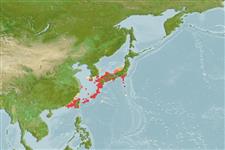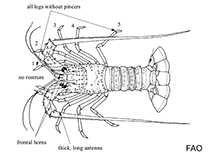Panulirus japonicus (Von Siebold, 1824)
Japanese spiny lobster| Native range | All suitable habitat | Point map | Year 2050 |

|
| This map was computer-generated and has not yet been reviewed. |
| Panulirus japonicus AquaMaps Data sources: GBIF OBIS |
Upload your photos
Google image | No image available for this species;
drawing shows typical species in Palinuridae.
Google image | No image available for this species;
drawing shows typical species in Palinuridae.
Classification / Names Common names | Synonyms | CoL | ITIS | WoRMS
Malacostraca | Decapoda | Palinuridae
Environment: milieu / climate zone / depth range / distribution range Ecology
Benthic; depth range 1 - 15 m. Subtropical; 39°N - 22°N, 116°E - 142°E (Ref. 4)
Distribution Countries | FAO areas | Ecosystems | Occurrences | Introductions
Western Pacific.
Length at first maturity / Size / Weight / Age
Maturity: Lm 4.2 range ? - ? cm Max length : 30.0 cm TL male/unsexed; (Ref. 4); common length : 25.0 cm TL male/unsexed; (Ref. 4)
It has lengths of 30 cm, maximum total body length; 25 cm, common length (Ref. 4). Occurs in depths between 1 and 15 m on rocky bottoms and inhabits shallow waters (Ref. 4).
Life cycle and mating behavior Maturity | Reproduction | Spawning | Eggs | Fecundity | Larvae
Members of the order Decapoda are mostly gonochoric. Mating behavior: Precopulatory courtship ritual is common (through olfactory and tactile cues); usually indirect sperm transfer.
Main reference
References | Coordinator | Collaborators
Holthuis, L.B. 1991. (Ref. 4)
IUCN Red List Status (Ref. 130435)
Data deficient (DD) ; Date assessed: 03 December 2009
CITES status (Ref. 108899)
Not Evaluated
CMS (Ref. 116361)
Not Evaluated
Threat to humans
Human uses
Fisheries: commercial
FAO - Aquaculture: production; | FishSource | Sea Around Us
Tools
More information
Internet sources
BHL | BOLD Systems | CISTI | DiscoverLife | FAO(; publication : search) | Fishipedia | GenBank (genome, nucleotide) | GloBI | Gomexsi | Google Books | Google Scholar | Google | PubMed | Tree of Life | Wikipedia (Go, Search) | Zoological Record
Estimates based on models
Preferred temperature
(Ref. 115969): 19.3 - 25.3, mean 22 (based on 176 cells).
Resilience
(Ref. 69278):
High, minimum population doubling time less than 15 months (K=0.39).



